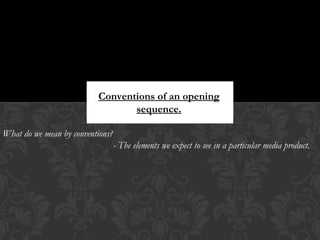
Opening Sequence Conventions
- 1. Conventions of an opening sequence. What do we mean by conventions? - The elements we expect to see in a particular media product.
- 2. EQUILIBRIUM Most films would start with equilibrium which is an idea of normality. This means that it would first start of with something positive and then introduce something negative. However, thriller would start with disequilibrium. This means that it would start with someone negative and then end with something positive. An example of a film that has used equilibrium first would be An example of disequilibrium being used at the beginning of the film is,
- 3. CLOSE UPS AND EXTREME CLOSE UPS A director would have a put a close up shot into an opening sequence as it allows the audience to see the characters face. Also, by using close ups it shows the audience the thoughts, feelings and emotions of the character. An example of films that has used close ups are ‘Spiderwick Chronicles’, ‘Matilda’ and ‘Saw’. A director would put extreme close ups into an opening sequence as it allows the audience to see a particular things in greater detail. An example of film’s that has used extreme close ups are ‘Memento’, ‘Wallander’ and ‘Brick’.
- 4. TITLES Titles are what the director would put at the beginning of the film. They inform the audience all of the people that have help to create the film. The titles can be many different colours, sizes and fonts, the directors would have thought thoroughly about what colour, size and font they use as it helps to add effect to the film and also lets the audience know what type of genre its going to be. For example, the titles used in ‘Bridget Jones Diary’ are wrote in a font which looks like handwriting, this links to that the film is called ‘Bridget Jones Diary’. Another example of titles used is in the film called ‘The Sixth Sense’. They have used a font called ‘Serif ’, this is because it adds a more serious effect to the film.
- 5. SOUNDTRACK The soundtrack is a non-diegetic sound that is used throughout the opening sequence to create a mood/atmosphere. Also, by adding a soundtrack, it lets the audience know what to of film to expect. For example, ‘The Sixth Sense’ use quite a dramatic soundtrack which suggests to the audience that the film their about to watch is going to be scary and dramatic. Another example is ‘Bridget Jones Diary’, in this opening sequence the soundtrack used is quite depressing as it is about being on your own – which links to the film well as it is talking about Bridget's life and how she's lonely without a partner. The last example is ‘Spiderwick Chronicals’. This opening sequence uses quite a soft, sparkly soundtrack which suggests to the audience that the film is going to be magical.
- 6. ESTABLISH MOOD/THEME It is always good to establish the mood or theme throughout the opening sequence as it gives the audience an idea as to what the film is going to be about and what genre it is. The cinematography, mise en scene, sound/music and editing help to establish to mood/theme. For example, the films called ‘The girl with the dragon tattoo’, ‘The orphan’ and ‘Bridesmaids’ have all used cinematography, mise en scene, sound/music and editing within their opening sequences to help establish the mood and theme.
- 7. ESTABLISHING SHOT The director would add establishing shots within an opening sequence as it shows the audience what location the character is in and what kind of surrounds are around the character/s. For example, in the film ‘Brick’ it has a wide shot of the boy standing at his locker and you can see everything in his background. This is done to let the audience know what type of environment the boy is in.
- 8. PROMPTS THE AUDIENCE TO ASK QUESTIONS The director will put moments in the opening sequence that prompt the audience to ask themselves questions. They do this as it makes the audience more intrigued to know what's happening or going to happen next. An example of prompts being used is in ‘Wallander’ when it has the man in the car covered in blood, the fact that he was covered in blood makes the audience question themselves as to why and what has happened.
- 9. GIVES THE AUDIENCE CLUES The director will add things into the opening sequence which will be little clues to the audience. The clues will be a little bit of information but not enough for the audience to completely understand what is going on. By adding clues to the opening sequence, it gives the audience enough information for them to be intrigued as to what is happening and make them want to carry on watching the rest of the film. For example, the film ‘Brick’ has used clues. We can see this when there is a close up of the boy holding the note which the girl had put into his locker. This is a clue to the audience because it gives them a little bit of information for them to know where the girl wants the boy to meet her but still doesn’t give them enough information for them to know what has actually happened to the girl.